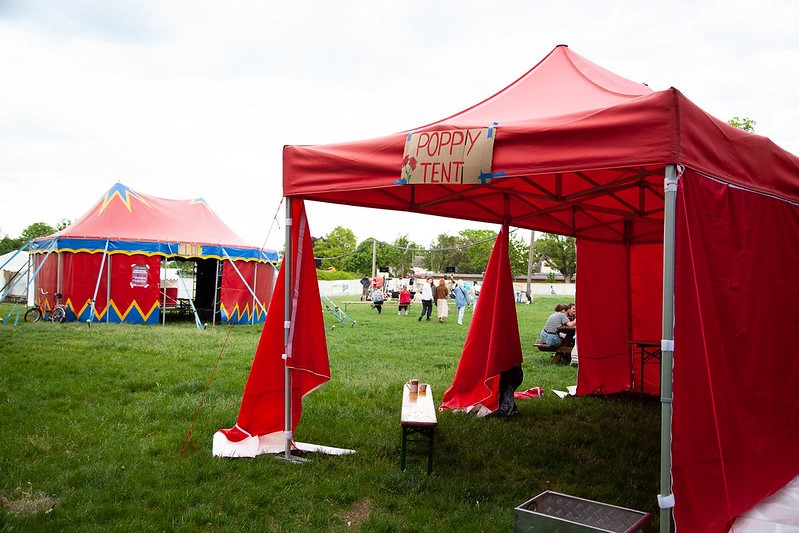Self-Organization as a Form of Governance of Common-Pool Resources
I originally wrote this article for university a view years ago. I first published it at https://derknoten.wien in 2020.
Abstract
At the core of climate change is the problem of regulating the access to common-pool resources. Self-organization has been proposed as a mode of regulating the access to these resources. This paper examines existing literature on the conditions under which this self-organization can occur and how they relate to climate change.
1 Motivation
I have been interested in alternative governance for a while, especially in decentralization and self-organization. In my search for effective alternatives to the frustratingly slow and ineffective governance models that we as a global society have been employing, I came across self-organization as a concept of systems theory a while ago. Since it is my ambition, to contribute to a shift in perception of options for human behavior in the face of existential crisis, I want to try and explain some concepts and ideas relating to the governance of climate-change and other global scale governance challenges.
2 Introduction and Definitions
To understand problems related to climate change and the governance of global commons in general, the research around the tragedy of the commons and common-pool resources is helpful. This paper aims at providing an overview over the topic of common-pool resources, a (non-comprehensive) summary of the research on self-organization of common-pool resources and some more climate specific implications and thoughts.
2.1 Common-Pool Resources
Common-pool resources are characterized by two properties: access to the resource and the nature of the flow of benefits. If it is difficult or costly to exclude potential users from a resource and if the use of the resource by one user, subtracts from the availability to other users, i.e. if it has a finite flow of benefits, a given resource is called a common pool resource (Ostrom et al. 1994). A classic example would be fish in the ocean. It is virtually impossible to exclude anyone from fishing in the ocean. Anyone that does so, decreases the stock of fish that is available to others, i.e. the resource “yield[s] a finite flow of benefits” (Ostrom 2008). The concept can be applied to other resources in the same simple way, e.g. forests and the wood that grows in them, or rivers and the water that flows in them. But it can also be applied to climate change, or more precisely the atmosphere, as will be discussed under 2.3. A common-pool resource consists of a resource system, that holds a stock of a given resource, e.g. the amount of fish in the ocean. A flow of resource units out of the system occurs through appropriation of those units by the users (Ostrom 2015, 30). Common-pool resources are different from public goods in the nature of the flow of benefits. Public goods do not have a finite flow of resources, for example good air quality doesn’t become less, just because more people benefit from it.
2.2 Tragedy of the Commons
The tragedy of the commons was first described by Hardin (1968). His original example to illustrate the problem was that of a pasture on which many herders let their cattle graze. The pasture in this example is the common-pool resource. The tragedy begins, when one of the herders notices that they can easily put more cattle on the pasture and in doing so increase their yielded benefit. The other herders soon start doing the same, so after some time the whole pasture is depleted and none of the herders can yield any benefit from it anymore. The underlying assumption to this behavioral model is that the users of a resource behave like rational agents. A rational agent seeks maximum individual benefit and considers all available options logically only with regards to this intention. Any agent experiences the full benefit of adding cattle to their herd, but the negative effects of overgrazing are shared between all agents. Because the subjective benefit of selfish behavior outweighs the cost, there is an incentive for selfish and unsustainable behavior. Another condition for the unfolding of a tragedy of the commons is a large group of users, where no one has rights to the resource, more than anyone else (Ostrom 2008). This will become very relevant in later sections, when we look at how this all relates to climate change. Originally it was thought that a common-pool resource would always end up as a tragedy of the commons if one of two possible mechanisms of governance were not applied. The first is privatization of the resource and allocation of resource units through a market economy. This method only works though, if exclusion costs are low, otherwise unauthorized users can’t be prevented from using the resource despite it being private property (Paavola 2011). The other is a centralized instance of control, that allocates access to the resource. This institution also needs to ensure the public obeys the imposed regulations, such as a state or national government agency. More recent research of the topic suggests that there is a third option: self-organization among stakeholders to produce a governance system for a given resource, without a central institution like a state stepping in and providing regulation (Ostrom 2008).
2.3 Climate Change as a Tragedy of the Commons
The pollution of the atmosphere and the resulting climate change are not a problem of extraction, like the examples above, but rather a problem of accumulation (of course it is also related to the extraction of fossil fuels, but we will focus on the accumulation side of things for now). In this case the resource users do not calculate the benefit of extracting more than they should and compare it to the long-term cost. Rather they calculate the cost of internalizing their waste management and compare it to the long-term cost of externalization. Since the long-term cost is shared among all users it is lower than the cost of internalization (Hardin 1968). The cost of polluting the atmosphere is not paid by any individual but is shared by the global society. Because of this, it is cheaper for any individual or organization to emit greenhouse gases, rather than take care of their “waste” or use other methods that produce less emissions. A more formalized way of defining the atmosphere as a common-pool resource is provided by Paavola (2011), in viewing atmospheric green-house-gas (GHG) sinks as “stock resources which provide a flow of sink services”. Related to this perspective, the greenhouse gas budget, that humanity can spend and still reach a certain global warming target, can also be considered as a common-pool resource.
2.4 Self-Organization
In systems theory self-organization is understood as “the spontaneous emergence of a large system via the collective innovations of several simple and smaller systems” (Chermack 2004). It is a property of mechanistic systems, for example a dust cloud collapsing into a solar system (Collier 2004) or a chain of amino acids folding in to a protein. Self-organization occurs on all hierarchical levels of the universe: atoms forming molecules, just by virtue of being close to each other; the cells of any living organism producing its own components, that self-organize to renew the cell structure; eco systems, that self-organize to find a stable balance of primary producers, herbivores and predators; social systems that self-organize to govern community live on all scales, or to raise awareness of crucial issues, e.g. the Fridays for Future movement. The most important characteristic of self-organization is, that it spontaneously emerges in a decentralized fashion. Meadows (1999) described self-organization as “basically the combination of an evolutionary raw material — a highly variable stock of information from which to select possible patterns — and a means for experimentation, for selecting and testing new patterns”. She also ranked the power to self-organize as a highly effective way of changing a system in the same paper on leverage points. In the case of governance of common-pool resources the “evolutionary raw material” (Meadows 1999) would be recorded history with the wide variety of governance models on all different levels that are known to human kind. Experimentation is necessary to find new ways of governance that achieve a more sustainable use of common-pool resources.
2.5 Research Question
After laying out these basic definitions and relations, naturally emerges: What are the conditions, that must be met, so that users of a common-pool resource, can self-organize to form a governance system, especially with regards to climate change?
3 Conditions for Self-Organization and Limitations
3.1 Comparison of Climate Change and other Tragedies of the Commons
Climate change is different to other tragedies of the commons, not in the mechanics of how it came to be a tragedy, but rather with regards to the scale at which it occurs. Climate change is a problem of pollution of the atmosphere. The atmosphere spans the whole world and every single human being on this planet is a user of the atmosphere and therefore of the common-pool resource at the heart of climate change. This means the highest possible number of users and the highest diversity in interests of these users are involved. As we will see later, this is one of the most crucial challenges with regards to self-organization.
3.2 Conditions for Self-Organization
According to Collier (2004) the conditions for the self-organization of a system are cohesion, i.e. some form of interaction and an input of energy, proportionate to the entropy of the system. If those requirements are met a system self-organizes, to minimize entropy production and “take the path of least resistance” (Collier 2004). Even though these generalizations are derived from a rather mechanistic systems approach, they provide a kind of abstract metaphor for the conditions for self-organization around a common-pool resource described by Ostrom (2008). Ostrom provides the capacity for individuals to communicate as the most basic requirement. This is equivalent to cohesion between a system’s elements in mechanistic systems. Furthermore, Ostrom reports, that a low discount rate of a given common-pool resource plays a crucial role. The discount rate describes the preference of a received benefit now over a benefit that is received later in time by the users of a common-pool resource. A low discount rate means that benefit flows in regularly at a lower rate, whereas a high discount rate would mean, that benefits that are received sooner are valued higher. In practice a low discount rate means, that most resource users rely on being able to use a resource for a long time and have an interest in preserving it. Another important condition is mostly homogenous interest and capacity to pursue their interest among all users of a resource (Ostrom 2008). As a last factor Ostrom (2008) provides the cost of agreement and enforcement, that both need to be low, in order for self-organization to occur. According to Ostrom, once these conditions are fulfilled, resource users are willing to invest a lot of time and energy in to building institutions for the governance of their respective resource (Ostrom 2008) and give up short term benefit for the sake of long term sustainability. For this to work Paavola (2011) provides another condition, that is, all users must feel like their efforts in preserving the resource are not lost, but they can actually achieve something. According to Ostrom (2008) the first step in building a governance system needs to be the establishment of so called “boundary rules”. These rules determine where the resource system begins and ends; who is entitled to how big of a share of the flow of benefits; the territory that a governance unit is responsible for and what duties users have (Ostrom 2008).
3.3 Climate Change Specific Conditions for Self-Organization
When the conditions listed under 3.2 are applied to a global context, the real magnitude of climate change as a challenge becomes apparent. As mentioned under 3.1 all humans are users of the atmosphere and therefore conditions for self-organization must apply globally. The first condition of uncostly communication among all users seems to be fulfilled in times of the internet, but it might not be that simple. Communication between those being responsible for the biggest contributions to emissions and those most affected by it is close to non-existent. Also, we have not yet found a tool to manage the discourse of nearly 8 billion people. Furthermore, humanity is a very diverse group with very heterogenous interest. Small-holder farmers in rural areas of developing countries and organizations that mine oil and sell it for use as an energy source are examples for two ends of the spectrum of interests. Discount rates seem to be low in some parts of the global population, most likely among those who are already experiencing negative impacts of climate change, but also among climate activists and environmentalists in developed countries. On the other hand, many individuals and organizations, still seem to prefer a high flow of benefits right now over a more moderate but consistent flow overtime. Finally, the cost of global agreement is very high. The best tool now to reach something close to a global agreement on climate change are the United Nations Framework Convention on Climate Change (UNFCCC) conferences of the parties (COP) were delegates from all countries negotiate global public climate legislation each year. The agreements reached at these summits must be agreed upon unanimously, which makes it very difficult for ambitious players like small island developing states who are most adversely affected by climate change, to push for bold global climate legislation. The cost of the “smallest common denominator” agreements, that are the results of COPs, is very high in the sense that it is a slow and inefficient process and the results lack ambition. It is even questionable if the achieved agreements can be viewed as global agreements at all, since only governments of countries can play an active role in them. To get around these challenges with global collective action Paavola (2011) proposes to focus efforts on local collective action. He argues that the incentive to free-ride is lower on a smaller scale, since the positive impacts of each individuals action are felt more directly and that interests are more likely to be more homogenous in smaller-scale groups. I would like to add to the list of advantages of small scale collective action, the lower cost of communication, agreement and enforcement. Paavola (2011) suggests that small scale collective action groups could coordinate among each other, through a sort of multi-leveled system of agreement, where representatives of all groups agree to ensure global alignment of local collective action. He admits that nation states coordinating within the UNFCCC constitute one manifestation of such a leveled governance system, but notes that there might be other organizational structures, that are more apt to the challenge at hand. He goes on to argue that the cost of transactions is a determining factor for the shape that any governance system takes and that this cost is largely determined by the specific aspect that an institution aspires to govern. Since global interests are diverse and different aspects of governance best operate at different costs of transactions, Paavola (2011) argues that “multiple non-comprehensive solutions are a more likely outcome to emerge than one, all-encompassing governance solution […]”.
4 Conclusion
To summarize, doubts about the aptness of current governance methods are rooted in a big body of research, of which we have barely scratched the surface in this paper. It seems as though self-organization might be a more powerful mode of governing common-pool resources, but the conditions for it to occur are not met on a global scale. Since it is unlikely that the conditions will be met on a global scale, but are more easily fulfilled on a smaller scale, local self-organization is likely going to be a major component in governing common-pool resources to avoid catastrophic climate change. But since global coordination is still necessary a multi-level decentral governance system is likely to emerge. The concept of self-organization as an approach to governance of common pool resources seems to offer some valuable insights into the diversity of governance models available. This alone is a valuable insight: to realize that nation states, bargaining at international conferences are not the only thinkable way in which global and local governance can play out.
5 References
Chermack, Thomas. 2004. “The Role of System Theory in Scenario Planning.” Journal of Futures Studies (8): 15–30.
Collier, John. 2004. “Self-organization, Individuation and Identity.” Revue internationale de philosophie n° 228 (2): 151–72. https://www.cairn.info/load_pdf.php?ID_ARTICLE=RIP_228_0151&download=1. Hardin, Garrett. 1968. “The Tragedy of the Commons.” Science (162): 1243–48.
Meadows, Donella. 1999. “Leverage Points: Places to Intervene in a System.” The Sustainability Institute.
Ostrom, Elinor. 2008. “Tragedy of the Commons.” In the New Palgrave Dictionary of Economics (2nd Edition).
— — — . 2015. Governing the Commons: The Evolution of Institutions for Collective Action. Canto Classics. Cambridge: Cambridge University Press. http://search.ebscohost.com/login.aspx?direct=true&scope=site&db=nlebk&AN=1077401.
Ostrom, Elinor, Roy Gardner, James Walker, James M. Walker, and Jimmy Walker. 1994. Rules, Games, and Common-Pool Resources: University of Michigan Press.
Paavola, Jouni. 2011. “Climate Change: The Ultimate ‘Tragedy of the Commons’.” Property in land and other resources, 417–34.




